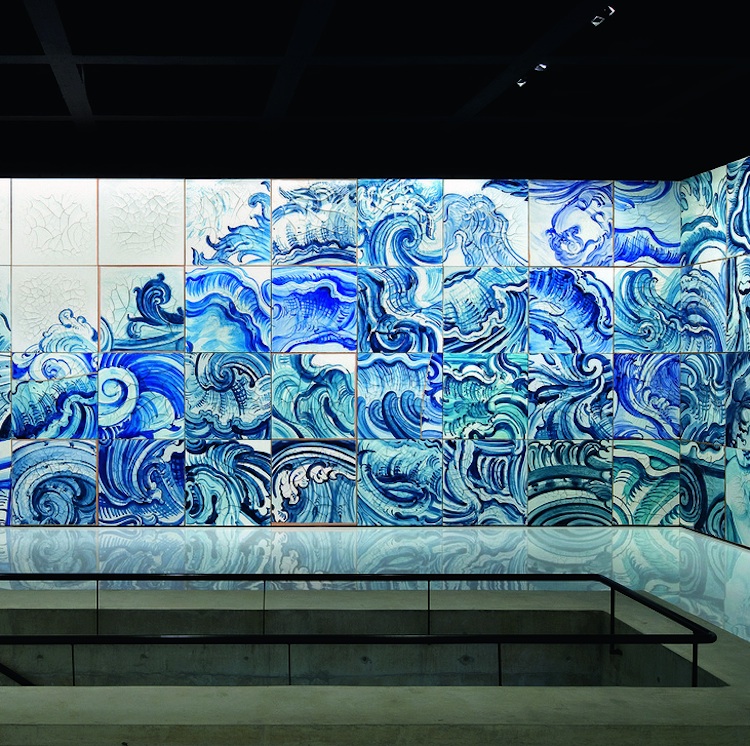RIO DE JANEIRO, Brazil — Adriana Varejão isn’t afraid of a little blood. In fact, much of her work uses the austerity of blue and white tile combined with suggestions of gore and violence to confront uncomfortable, tragic historical topics such as slavery and colonialism. Varejão isn’t content to let these things stay buried. She’s honest, recognizing that the grotesque, shameful violence from the past is running under the hood of our modern lives. You don’t get to appreciate her blue and white tile without acknowledging where it came from; that’s the cost of admission.

Brazil’s Olympic swimming stadium.
With that in mind, the Olympics committee in Brazil made a very bold choice when they selected Varejão to create the facade of the swimming stadium for the 2016 games in Rio de Janeiro. Drawing on her aquatic works such as Celacanto Provoca Maremoto (2004-2008) at Centro de Arte Contemporanea Inhotim in Minas Gerais, Brazil. (pictured in this post), Varejão is creating a sea scene for the stadium. From a distance (and even up close, from what we’ve read) it appears as though the building is covered in cracked, weatherworn tile. But in fact, according to the New York Times:
(W)hat appears to be ancient, cracked decorative tile is actually a scrim of 66 panels of perforated canvas, each 90 feet high — the largest contemporary artwork commissioned for Rio 2016. And the blue-and-white work is steeped in a complicated past that is typical of its creator, Adriana Varejão, 51, the revered Rio artist.
“If you look closely, it’s not just a seascape, ” she said recently, speaking via Skype from her Rio studio, “but parts of angels, and other historic Baroque motifs, all fragmented, reordered and turbulent.”
…
The as-yet-untitled commission’s tiled appearance is a double trompe l’oeil, because it is composed of printed images from an older Varejão artwork called “Celacanto Provoca Maremoto” (“The Coelacanth Causes a Seaquake”). For that work, created between 2004 and 2008, Ms. Varejão encrusted with plaster 184 panels, each roughly 43 inches square.
Then she let the panels crack and painstakingly painted onto them fragments of images from her digital inventory of more than 2,500 tiles.

Installation of Adriana Varejão, Celacanto Provoca Maremoto, at Inhotim. Photographs of installation by Eduardo Eckenfels.


For the mural at Inhotim she created an abstract ocean scene by mixing tiles from different compositions. The artist said the title of the work, Celacanto Provoca Maremoto, translates to “coelacanth causes a seaquake.” The coelacanth is a very rare species of fish, thought to be extinct until modern times.
We haven’t seen the swimming pool display anything quite as brazen as some of her other work, but there’s a social dynamic informing Varejão’s callback to blue and white azuelo tile. From Artsy:
The work is part of Varejão’s ongoing explorations into the traditions of azulejos, hand-painted tiles in Brazil that trace back to when the Portuguese imported Baroque tiles, which were inspired by the cobalt-blue ceramics that Europeans encountered in China. For decades, Varejão has been creating paintings and installations that investigate this history, often mimicking cracked, broken tiles, which not only reference the Brazilian tradition, but also Chinese Song dynasty ceramics.
Do you love or loathe this work of (not quite) contemporary ceramics? Let us know in the comments.

Adriana Varejão photograph by Vicente de Mello. Click to see a larger image.


Just because she’s an artist from Latin America doesn’t mean all of her works are ONLY meant to be interpreted on a historical/political realm…
https://hyperallergic.com/168901/considering-brazils-racial-heritage/
See what Adriana herself has to say about being a “Latin American” artist instead of just an artist
Wow, truly stunning!
This is SO marvelous! Thank you, CFile, for compiling coverage from a number of sources and adding your own spin to the story. You always do that so well. I’ll be sharing on MAN.